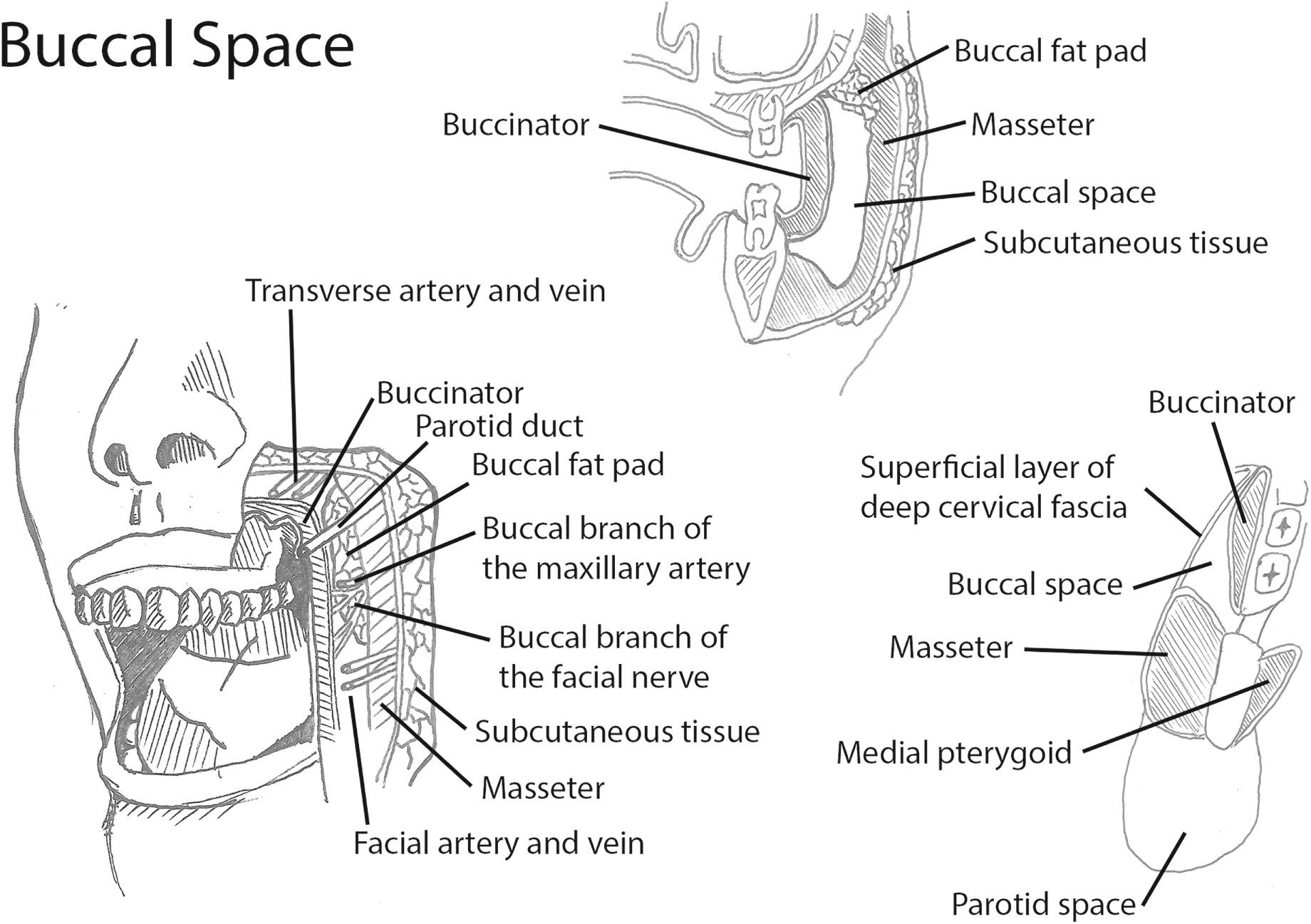Physical Address
304 North Cardinal St.
Dorchester Center, MA 02124
Buccal space tumors may arise from salivary tissue, facial artery and vein, mandibular and facial nerves, adipose tissue, muscular, and lymphoid tissue. Additionally, the buccal space can be involved by direct invasion or metastasis from regional or distant cancer. Tumors in the buccal space tend to overlap in their clinical presentations and radiologic findings often are nonspecific. Definitive diagnosis commonly requires a biopsy by fine needle, core, or excisional biopsy. If biopsy fails to reveal the diagnosis, a surgical excision may be indicated for diagnostic and therapeutic purposes.
The most common primary tumors of the buccal space are from the minor salivary glands, followed by the accessory lobe parotid tumors. Less common tumors include rhabdomyosarcoma, rhabdomyoma, neurofibroma, neuroma, schwannoma, liposarcoma, lipoma, hemangioma, epidermal cyst, and lymphoma. Other miscellaneous conditions presenting in this region include Kimura disease and foreign body granulomas. The accessory parotid gland may extend into the buccal space and has been reported to be present in a large proportion of the population – ranging from 20% to over 60%. It has the potential to be affected by any of the inflammatory, autoimmune, infectious, and other conditions that occur in salivary tissue.
The buccal space is a potential fascial space occupying the bulk of the cheek ( Fig. 43.1 ). The buccal space is bounded medially by the buccinator muscle and its fascia and laterally by the muscles of facial expression: the lesser and greater zygomatic muscles and the risorius muscle. The posterior border is formed by the masseter muscle, mandible, lateral and medial pterygoid muscles, and the parotid gland. The superior and inferior borders are defined by the attachment of the superficial layer of deep cervical fascia to the periosteum of zygoma superiorly and the mandible inferiorly.

The buccal space contains adipose tissue of the buccal fat pad termed “Bichat's fat pad”. The buccal fat pad has four projections (lateral, medial, anterior, and superior) that might act as a route for spread of infection or malignancy. Minor salivary glands are within the buccal space. Radiologically, the facial vein on axial section divides the buccal space into anterior and posterior compartments. Neural structures of the buccal space include the buccal and zygomatic branches of the facial nerve, and the buccal branch of the mandibular nerve, which supplies general sensation over the buccal mucosa and skin. The main buccal branch of the facial nerve is in close proximity to Stensen's duct. The buccal space also includes lymphatic channels and buccal lymph nodes along the lateral margins of the buccinator muscles.
Another structure close to the buccal space is the juxtaoral organ (organ of Chievitz) located within the soft tissue overlying the angle of the mandible in the buccotemporal space. In children, this normal organ may be discovered as a small mass in the cheeks, which may lead to unnecessary investigations.
An accessory parotid gland lies adjacent to Stensen's duct and is distinctly separated from the main body of the parotid gland. The average distance of separation between the main parotid gland and the accessory parotid gland is 6.0 mm. Parotid tissue that lies anterior to the main duct with no distinct separation from the main gland is considered to be an anterior facial process of the main gland. The prevalence of an accessory parotid gland reported in two studies was 21% and 69%. The gland usually lies above or on Stensen's duct but is occasionally inferior. The accessory parotid gland empties into the main parotid duct through variable tributary ducts warranting ligation (when surgically resecting the lobe) to decrease risk of postoperative salivary fistula.
The accessory parotid gland is situated along the course of the buccal and zygomatic branches of the facial nerve that may be intimately involved with accessory parotid gland tumors. The transverse facial artery usually provides a blood supply to the accessory parotid gland.
The accessory parotid gland exhibits the same potential for developing disease as the main parotid gland. The prevalence of accessory parotid gland tumors when considered as a subset of all parotid gland neoplasms has been reported to be between 1% and 8%. The risk of malignancy among accessory parotid gland tumors has been reported to be higher than those arising elsewhere in the parotid gland. The most common benign neoplasm is pleomorphic adenoma and the most common malignant tumor is mucoepidermoid carcinoma.
The history focuses on the characteristics and progression of the cheek mass, including trismus, facial or mandibular nerve dysfunction, and altered salivary function. The physical examination should ascertain the mass characteristics, changes of the overlying skin and mucosa with attention to facial and mandibular nerves, mouth opening, salivary output, and cervical lymph nodes. A compressible mass that changes in size with gravity might suggest lymphovascular origin.
Accessory parotid gland tumors may present as a painless cheek mass located over the middle third of the line that extends from the tragus to the midpoint between the vermilion of upper lip and the ala of the nose.
Become a Clinical Tree membership for Full access and enjoy Unlimited articles
If you are a member. Log in here